 At the end of the 1957 production season, Alfa Romeo eventually decided that the time was right to discontinue their 1900 series, bringing in the 2000 to replace it.
At the end of the 1957 production season, Alfa Romeo eventually decided that the time was right to discontinue their 1900 series, bringing in the 2000 to replace it.
To make things a little more straightforward, this time around, Alfa released the 2000 in a choice of three standard body styles, a standard sedan under the Berlina label, the Sprint Coupe and the Spider convertible.
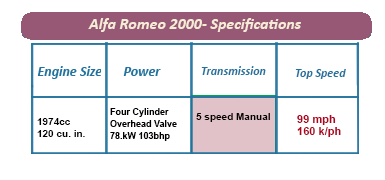 For the " bread and butter" Berlina, Alfa Romeo used their in-house design department to develop the model.
For the " bread and butter" Berlina, Alfa Romeo used their in-house design department to develop the model.
For the Sprint and Spider, Alfa farmed out all of the design and development to outside sources.
 The ultra-talented Giorgetto Giugiaro from the Turin-based design studio Bertone was handed the task of styling the 2000 Sprint.
The ultra-talented Giorgetto Giugiaro from the Turin-based design studio Bertone was handed the task of styling the 2000 Sprint.
It was evident from day one that Alfa Romeo's faith, as well as their considerable investment, was going to pay off.
![]()
The results would come both in the short-term as well as the long-term, with the Sprint design culture going on to shape several general generations of Alfa Romeo Sprints.
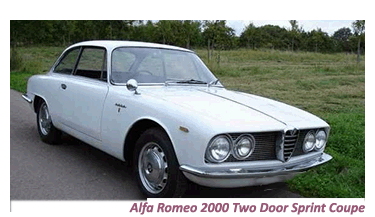 The Carrozzeria Touring Superleggera design studio, with a history of association with Alfa Romeo going back more than eight decades, were the obvious choice to create the Spider Convertible.
The Carrozzeria Touring Superleggera design studio, with a history of association with Alfa Romeo going back more than eight decades, were the obvious choice to create the Spider Convertible.
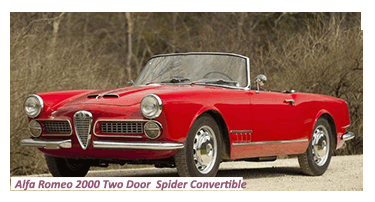 Alfa charged "Touring" with the responsibility of developing the Spider's to appeal to the European market as well as their rapidly expanding client base in the US.
Alfa charged "Touring" with the responsibility of developing the Spider's to appeal to the European market as well as their rapidly expanding client base in the US.
This meant designing the car that would appeal to both markets, with Europe still a follower of understated design and North America where design excesses were becoming increasingly commonplace.
Touring succeeded in coming up with a design that amply covered both markets, with the Spider fitted with Alfa's traditional "reverse" triangle grille poking down beneath a split front bumper.
Decorative vents and twin hood scoops marked the only extravagant design features of the 2000.
![]()
The overall impression of the Alfa Romeo 2000 Spider was neither too large or small. The Spider went on to prove itself to be as equally suited for cruising down the highways of North America, the Autobahns of West Germany or the Autostradas of Italy.
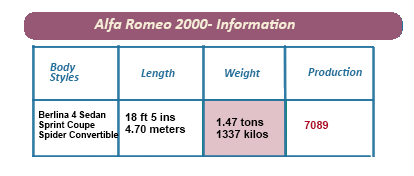 As was standard Alfa Romeo practice, the Berlina four-door sedan arrived first with the Sprint and Spider released later.
As was standard Alfa Romeo practice, the Berlina four-door sedan arrived first with the Sprint and Spider released later.
 Initially, there was some confusion in identifying the new models, as the 2000 was similar in appearance to the Giulietta, released in 1956.
Initially, there was some confusion in identifying the new models, as the 2000 was similar in appearance to the Giulietta, released in 1956.
![]()
The Spider and Sprint, in line with their sporty image, came fitted with a floor-mounted gear shift.
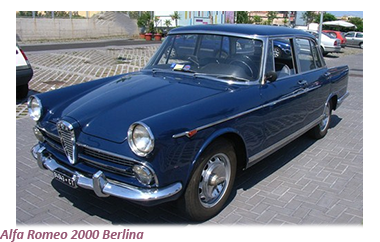 The Alfa Romeo 2000 series remained in production for just four model years, being discontinued in 1962, replaced by the considerably more powerful 2600 series.
The Alfa Romeo 2000 series remained in production for just four model years, being discontinued in 1962, replaced by the considerably more powerful 2600 series.
 Of the just over seven thousand 2000 series cars produced by Alfa Romeo, the Spider Convertibles made up a strikingly large part at 3,443, while 700 Sprint Coupes were built.
Of the just over seven thousand 2000 series cars produced by Alfa Romeo, the Spider Convertibles made up a strikingly large part at 3,443, while 700 Sprint Coupes were built.
In recent years, the 2000 Sprint and Spiders have begun to be regarded as classics, although the general impression among car enthusiasts is that had Alfa the foresight to fit the 2000 with a more powerful engine, maybe a 2.3 litre, then it would have been more warmly received.


